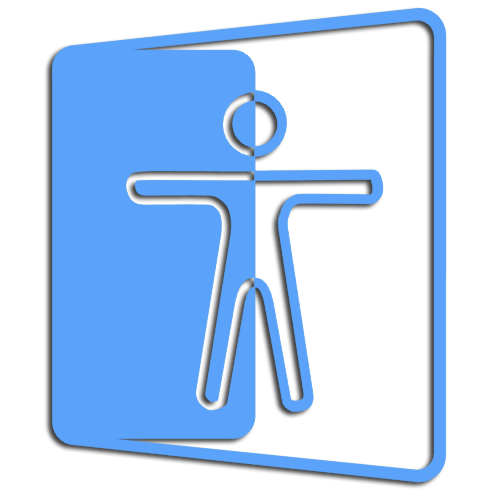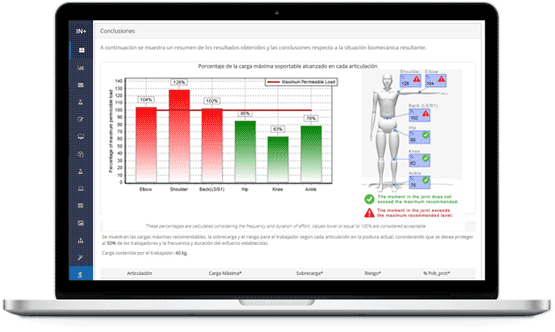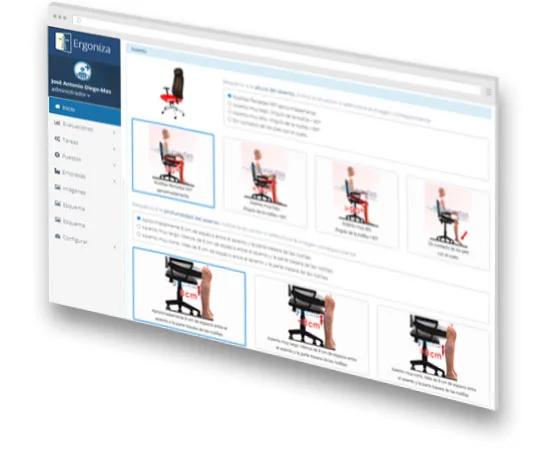

The evaluation of postural comfort is a key aspect of ergonomic work analysis, as it allows for the identification of postures that may cause discomfort, fatigue, or musculoskeletal disorders. In this context, the LUBA method (Loading on the Upper Body Assessment) emerges as a systematic procedure aimed at analyzing trunk, neck, and upper limb postures in order to estimate the level of postural discomfort associated with a given task.
Unlike other widely used methods such as OWAS, RULA, or REBA, LUBA focuses exclusively on postural assessment, without considering the duration of the maintained posture or the magnitude of handled loads. This makes it a more specific method for evaluating postural stress in tasks where the load component is low, but postural demand is high or sustained. For example, it can be especially useful in inspection tasks, administrative work, or manual precision activities, where poor posture may be maintained for long periods, even in the absence of load handling.
The LUBA method was developed by Kee and Karwowski in 2001, based on observations and analyses of postures adopted in real work environments. The methodology is based on the evaluation of specific joint angles of the body and their correlation with levels of postural discomfort, which were empirically established through previous biomechanical and subjective perception studies.
LUBA is mainly applied to tasks that involve static or semi-static postures, both in standing and seated positions. Its application requires postural (angular) measurements, which can be obtained through direct observation, video recordings, or photo analysis. However, it is important to note that due to its nature, LUBA should not be used as the sole evaluation criterion for activities involving heavy load handling or highly dynamic tasks.
Remember...
The aim of the LUBA method is to assess the worker's level of postural comfort.
LUBA focuses exclusively on postural assessment, without considering either the duration of the maintained posture or the magnitude of the handled loads.
Remember...
LUBA stands for Loading on the Upper Body Assessment. Unlike the RULA, REBA, or OWAS methods, it is a specific method designed to assess postural stress in tasks where the load component is low but postural demand is high or sustained.
The application of the LUBA method requires following a structured sequence of steps, including identifying the posture to be analyzed (individual postures must be assessed), measuring the relevant joint angles, and assigning discomfort scores to each body segment. These scores are then integrated to calculate a global postural load index, which allows the situation to be classified into one of the defined action categories.
It is essential to analyze the right side and left side of the body independently, as there may be significant postural differences between them. Likewise, the method distinguishes between tasks performed in a standing position and those carried out in a seated position, as joint ranges and biomechanical demands vary depending on the general body posture.
The measurements to be taken on the worker's postures are angular (the angles formed by different body segments in relation to specific references). These measurements can be taken directly from the worker using goniometers, electrogoniometers, or any device that allows angular data collection. It is also possible to use photographs of the worker adopting the studied posture and measure the angles on them. When using photographs, it is necessary to take a sufficient number of images from different viewpoints (front, side, detail views, etc.). In this case, it is very important to ensure that the angles to be measured appear in true magnitude in the images — that is, the plane in which the angle lies must be parallel to the camera plane. For this task, you can use RULER, the Ergonautas tool for measuring angles on photographs.
As mentioned, the method must be applied separately to the right and left sides of the body. The expert evaluator may initially choose the side that appears to be under greater postural load, but in case of doubt, it is preferable to analyze both
Remember...
LUBA assesses individual postures, not sets or sequences of postures. Select those to be evaluated based on their duration, frequency, or because they show greater deviation from the neutral position.
Remember...
If you use photographs to measure angles, make sure they appear in true magnitude in the images (see Figure 1).
RULER...
You can use RULER, the Ergonautas tool, to measure angles on photographs of the worker performing their task.
Remember...
The right and left sides of the body must be assessed separately. In case of doubt, analyze both sides.
The procedure for applying the LUBA method can be summarized in the following steps:
Select those postures that are likely to involve greater postural load, either due to their duration, frequency, or because they show greater deviation from the neutral position.
Determine whether to assess the left or right side of the body
In case of doubt, both sides should be analyzed.Take the required angular measurements
Photographs can be taken from appropriate viewpoints to perform the measurements. For this task, you can use RULER, the Ergonautas tool for measuring angles on photographs.Determine the relative discomfort scores for each body part
Using the corresponding table for each limb.Obtain the final scores to determine the presence of risk and establish the Action Category
If needed, determine what type of corrective measures should be taken
Review the scores for the different body parts to determine where corrections are necessary.Redesign the workstation or implement changes to improve posture, if necessary
If changes have been implemented, reassess the posture using the LUBA method to verify the effectiveness of the improvement
Did you know?
To facilitate data collection, Ergonautas offers this LUBA Method Field Sheet for applying the method. Click on the image to download it.

The body segments (or joints) considered by the LUBA method are the following: the wrist, elbow, shoulder, neck, and trunk. For each of them, specific joint angles must be measured. Below is a brief description of the angles involved and how they should be measured:
Wrist
Elbow
Shoulder
Neck
Trunk
The following section explains how to obtain the relative discomfort for each body segment, the final scores, and the risk category based on the measured angles.
Once the corresponding postural angles have been recorded and measured, the next step is to assign a relative discomfort score to each of them, using the tables shown below. Attention should be paid to whether the posture is standing or sitting, as the thresholds for postural comfort vary depending on the support base and overall body mechanics.
Each segment and angle receives a discomfort score based on the degree of deviation from a neutral posture. These scores reflect the level of postural demand for each part of the body.
Wrist Score
Flexion
The wrist flexion score is based on the angle between the forearm axis and the longitudinal axis of the hand in the plane perpendicular to the palm. The score is obtained using Table 1. If the wrist is not flexed but extended, a score of 1 is assigned.
| Angle (°) | Score (sitting) | Score (standing) |
|---|---|---|
| 0–20 | 1 | 1 |
| 20–60 | 2 | 2 |
| >60 | 5 | 5 |
Extension
The wrist extension score is based on the angle between the forearm axis and the longitudinal axis of the hand in the plane perpendicular to the palm. The score is obtained using Table 2. If the wrist is not extended but flexed, a score of 1 is assigned.
| Angle (°) | Score (sitting) | Score (standing) |
|---|---|---|
| 0–20 | 1 | 1 |
| 20–45 | 2 | 2 |
| >45 | 7 | 7 |
Radial Deviation
The wrist radial deviation score is based on the angle between the forearm axis and the longitudinal axis of the hand in the plane parallel to the palm. The score is obtained using Table 3. If the wrist is not radially deviated (toward the thumb) but ulnarly deviated (toward the little finger), a score of 1 is assigned.
| Angle (°) | Score (sitting) | Score (standing) |
|---|---|---|
| 0–10 | 1 | 1 |
| 10–30 | 3 | 3 |
| >30 | 7 | 7 |
Ulnar Deviation
The wrist ulnar deviation score is based on the angle between the forearm axis and the longitudinal axis of the hand in the plane parallel to the palm. The score is obtained using Table 4. If the wrist is not ulnarly deviated (toward the little finger) but radially deviated (toward the thumb), a score of 1 is assigned.
| Angle (°) | Score (sitting) | Score (standing) |
|---|---|---|
| 0–10 | 1 | 1 |
| 10–20 | 3 | 3 |
| >20 | 6 | 6 |
Elbow Score
Flexion
The elbow flexion score is based on the angle between the upper arm axis and the forearm axis in the plane formed by both. The score is determined using Table 5.
| Angle (°) | Score (sitting) | Score (standing) |
|---|---|---|
| 0–45 | 1 | 1 |
| 45–120 | 2 | 3 |
| >120 | 5 | 5 |
Pronation
The elbow pronation score is based on the angle of forearm rotation that positions the palm facing downward (pronation) from the neutral hand position (where the palm is parallel to the plane formed by the arm and forearm axes). The score is determined using Table 6. If the forearm is not pronated but supinated, a score of 1 is assigned.
| Angle (°) | Score (sitting) | Score (standing) |
|---|---|---|
| 0–70 | 2 | 2 |
| >70 | 7 | 7 |
Supination
The elbow supination score is based on the angle of forearm rotation that positions the palm facing upward (supination) from the neutral hand position (where the palm is parallel to the plane formed by the arm and forearm axes). The score is determined using Table 7. If the forearm is not supinated but pronated, a score of 1 is assigned.
| Angle (°) | Score (standing) | Score (sitting) |
|---|---|---|
| 0–90° | 2 | 2 |
| >90° | 7 | 7 |
Shoulder Score
Flexion
The shoulder flexion score is based on the angle between the upper arm and the trunk axis in the sagittal plane. Flexion occurs when the arm is raised forward. The score is obtained using Table 8. If the shoulder is not flexed but extended, a score of 1 is assigned.
| Angle (°) | Score (sitting) | Score (standing) |
|---|---|---|
| 0–45° | 1 | 1 |
| 45–90° | 3 | 3 |
| 90–150° | 6 | 6 |
| >150° | 11 | 11 |
Extension
The shoulder extension score is based on the angle between the upper arm and the trunk axis in the sagittal plane. Extension occurs when the arm moves backward. The score is obtained using Table 9. If the shoulder is not extended but flexed, a score of 1 is assigned.
| Angle (°) | Score (sitting) | Score (standing) |
|---|---|---|
| 0–20° | 1 | 1 |
| 20–45° | 4 | 3 |
| 45–60° | 9 | 6 |
| >60° | 13 | 10 |
Aducción
La puntuación del la aducción de hombro se obtiene a partir del ángulo entre el brazo y el eje del tronco en el plano frontal. La aducción se produce cuando el brazo se aproxima al tronco o incluso cruza hacia el otro lado del cuerpo. La puntuación se obtiene mediante la Tabla 10. Si el hombro no está aduccido sino abducido, se asigna la puntuación 1.
| Ángulo (°) | Puntuación (sentado) | Puntuación (de pie) |
|---|---|---|
| 0–10° | 1 | 1 |
| 10–30° | 2 | 2 |
| >30° | 8 | 8 |
Abduction
The shoulder abduction score is based on the angle between the arm and the trunk axis in the frontal plane. Abduction occurs when the arm moves away from the trunk. The score is obtained using Table 11. If the shoulder is not abducted but adducted, a score of 1 is assigned.
| Angle (°) | Score (sitting) | Score (standing) |
|---|---|---|
| 0–30° | 1 | 1 |
| 30–90° | 3 | 3 |
| >90° | 10 | 7 |
Medial Rotation
The shoulder medial rotation score is based on the rotational angle of the arm around its longitudinal axis. Medial (internal) rotation occurs when the arm rotates such that, if the forearm were flexed, it would move toward the trunk. The score is determined using Table 12. If the shoulder is not medially rotated but laterally rotated, a score of 1 is assigned.
| Angle (°) | Score (sitting) | Score (standing) |
|---|---|---|
| 0–30° | 1 | 1 |
| 30–90° | 2 | 2 |
| >90° | 7 | 5 |
Lateral Rotation
The shoulder lateral rotation score is based on the rotational angle of the arm around its longitudinal axis. Lateral (external) rotation occurs when the arm rotates such that, if the forearm were flexed, it would move away from the trunk. The score is determined using Table 13. If the shoulder is not laterally rotated but medially rotated, a score of 1 is assigned.
| Angle (°) | Score (sitting) | Score (standing) |
|---|---|---|
| 0–10° | 1 | 1 |
| 10–30° | 3 | 2 |
| >30° | 7 | 5 |
Neck Score
Flexion
The neck flexion score is based on the angle between the vertical and the trunk axis in the sagittal plane. It indicates how far the head leans forward. The score is determined using Table 14. If the neck is not flexed but extended, a score of 1 is assigned.
| Angle (°) | Score (sitting) | Score (standing) |
|---|---|---|
| 0–20° | 1 | 1 |
| 20–45° | 3 | 3 |
| >45° | 5 | 5 |
Extension
The neck extension score is based on the angle between the vertical and the trunk axis in the sagittal plane. It indicates how far the head leans backward. The score is determined using Table 15. If the neck is not extended but flexed, a score of 1 is assigned.
| Angle (°) | Score (sitting) | Score (standing) |
|---|---|---|
| 0–30° | 1 | 1 |
| 30–60° | 6 | 4 |
| >60° | 12 | 9 |
Rotation
The neck rotation score is based on the angle of head rotation relative to the neutral position (with the gaze perpendicular to the frontal plane). The score is determined using Table 16.
| Angle (°) | Score (sitting) | Score (standing) |
|---|---|---|
| 0–30° | 1 | 1 |
| 30–60° | 2 | 2 |
| >60° | 8 | 8 |
Lateral Bending
The neck lateral bending score is based on the angle formed by the neck relative to the trunk axis in the frontal plane. The score is determined using Table 17.
| Angle (°) | Score (sitting) | Score (standing) |
|---|---|---|
| 0–30° | 1 | 1 |
| 30–45° | 3 | 2 |
| >45° | 10 | 7 |
Trunk Score
Flexion
The trunk flexion score is based on the angle between the longitudinal axis of the trunk and the vertical, in the sagittal plane. It indicates how far the trunk leans forward. The score is determined using Table 18. If the trunk is not flexed but extended, a score of 1 is assigned.
| Angle (°) | Score (sitting) | Score (standing) |
|---|---|---|
| 0–20° | 1 | 1 |
| 20–60° | 3 | 3 |
| >60° | 10 | 6 |
| >90° | — | 12 |
Extension
The trunk extension score is based on the angle between the longitudinal axis of the trunk and the vertical, in the sagittal plane. It indicates how far the trunk leans backward. The score is determined using Table 19. If the trunk is not extended but flexed, a score of 1 is assigned.
| Angle (°) | Score (sitting) | Score (standing) |
|---|---|---|
| 0–10° | — | 1 |
| 10–20° | — | 4 |
| 20–30° | — | 8 |
| >30° | — | 15 |
Rotation
The trunk rotation score is based on the rotational angle of the trunk relative to the frontal plane. The score is determined using Table 20.
| Angle (°) | Score (sitting) | Score (standing) |
|---|---|---|
| 0–20° | 1 | 1 |
| 20–30° | 2 | 3 |
| 30–45° | 7 | 3 |
| 45–60° | 11 | 3 |
| >60° | 11 | 10 |
Lateral Bending
The trunk lateral bending score is based on the angle of side bending measured in the frontal plane. The score is determined using Table 21.
| Angle (°) | Score (sitting) | Score (standing) |
|---|---|---|
| 0–10° | 1 | 1 |
| 10–20° | 3 | 4 |
| 20–30° | 9 | 9 |
| >30° | 13 | 13 |
Once the relative discomfort scores for each body segment are obtained, the Postural Load Score or Postural Comfort Index (PCI) is calculated. The Postural Comfort Index is obtained by summing the individual discomfort scores for all segments evaluated on one side of the body. Therefore, two separate scores must be calculated: one for the right side and one for the left side.
Analyzing both sides independently makes it possible to detect postural asymmetries that might go unnoticed in a global evaluation.
Based on the PCI value, an Action Category is assigned, which indicates the recommended level of intervention. To determine the Action Category, use Table 22.
| Postural Comfort Index | Category | Risk Level | Recommended Action |
|---|---|---|---|
| 0 to 5 | 1 | Acceptable | This posture is acceptable, except in special situations such as prolonged duration or high repetition. No corrective actions are required. |
| 5 to 10 | 2 | Needs Improvement | This posture requires further investigation and corrective changes during the next regular review, but no immediate intervention is needed. |
| 10 to 15 | 3 | Requires Prompt Improvements | This posture requires corrective actions through redesign of the workstation or work methods in the short term. |
| >15 | 4 | Requires Immediate Improvements | This posture requires immediate attention and the implementation of urgent corrective actions. |
Despite its usefulness in specific contexts, the LUBA method presents several limitations that should be taken into account. Firstly, it does not consider the duration of exposure to a posture nor the frequency with which it is adopted, which may limit its ability to accurately predict the risk of injury. Likewise, LUBA does not incorporate the analysis of external loads or dynamic efforts, and therefore is not suitable for evaluating tasks that involve load handling, pulling, or pushing.
In addition, obtaining accurate postural angles can be labor-intensive. Moreover, the method was originally developed based on subjective discomfort data, which introduces a certain degree of individual variability in the interpretation of results.
Finally, although LUBA provides a clear classification of postural risk, it does not offer direct guidance on how to modify the task or redesign the workstation to reduce such risk. Therefore, it should be considered a screening tool that needs to be complemented with other ergonomic assessment techniques.
Kee, D. y Karwowski, W., 2001. LUBA: An assessment technique for postural loading on the upper body based on joint motion discomfort and maximum holding time. Applied Ergonomics, 32(4), pp. 357–366.
Genaidy, A.M., Karwowski, W. y Al-Shedi, A.A., 1994. Postural stress analysis in industry. Applied Ergonomics, 25(2), pp. 77–87.
Juul-Kristensen, B., Fallentin, N. y Ekdahl, C., 1997. Criteria for classification of posture in repetitive work by observation method: a review. International Journal of Industrial Ergonomics, 19(5), pp. 397–411.
Diego-Mas, J.A., Poveda-Bautista, R. y Garzon-Leal, D.C., 2015. Influences on the use of observational methods by practitioners when identifying risk factors in physical work. Ergonomics, 58(10), pp. 1660-70.
Diego-Mas, Jose Antonio. Postural assessment using the LUBA method. Ergonautas, Universitat Politècnica de València, 2025. Available online: https://www.ergonautas.upv.es/metodos/reba/reba-ayuda.php
A cloud based software that integrates more than 20 tools for managing the ergonomics of the workstations in your company.
Evaluate all ergonomic risk factors of the workstations in your company: inadequate postures, repetitive movements, load handling, thermal environment...

Use Artificial Intelligence for the automated detection of postures in photographs or videos.
Generate fully customizable reports in Microsoft Word or Adobe Pdf format.
In a multiuser environment so that your company can have access to your data everywhere.
You only need a free account on Ergoniza
ERGONIZA allows you to use Artificial Intelligence for postural load assessment. Automatically capture workers’ postures from a photograph or a video and obtain an automated evaluation of the risk associated with inadequate or forced postures.
AI in actionERGONIZA helps you manage the ergonomics of the workstations of your companies. Evaluate all the risk factors present in the workstations, manage the evaluations, and obtain editable and customizable reports.
You only need to register as a user of ERGONIZA to start testing.
Sign UpUnlock the full potential of Ergoniza. By becoming a Pro User you'll have access to all of Ergoniza and be able to use all of the online software without restrictions or time limits. You'll be able to use the results of evaluation methods and tools in your professional activity. You'll be able to print the results reports in pdf or Word and save your studies in files to open them later.
To register as a Pro user, you must first login to Ergoniza.
(*) In European Union countries, the price will be increased with the corresponding VAT.
(**) The price in american dollars has been calculated at the current exchange rate and may vary.
is a web by . Ergonautas is the specialized website in occupational ergonomics and ergonomic assessment of workstations at the . Ergonautas aims to be a useful support tool for the Occupational Risk Prevention and Ergonomics professional and people in training, providing rigorous technical information on occupational ergonomics, online tools for its application, research, training, and participation forums.
Ergonautas is formed by a large human team. In addition to technicians and programmers, the Ergonautas team is made up of researchers and professors from the Polytechnic University of Valencia. The team, led by José Antonio Diego Más, is at the forefront of research and teaching in ergonomics, teaching in official degrees and master's degrees, and developing research projects in the field of ergonomics and new technologies oriented towards humans.
If you need to know more, get in touch with Ergonautas
Or follow us on Linkedin
- - -
© 2006 - Universidad Politécnica de Valencia




